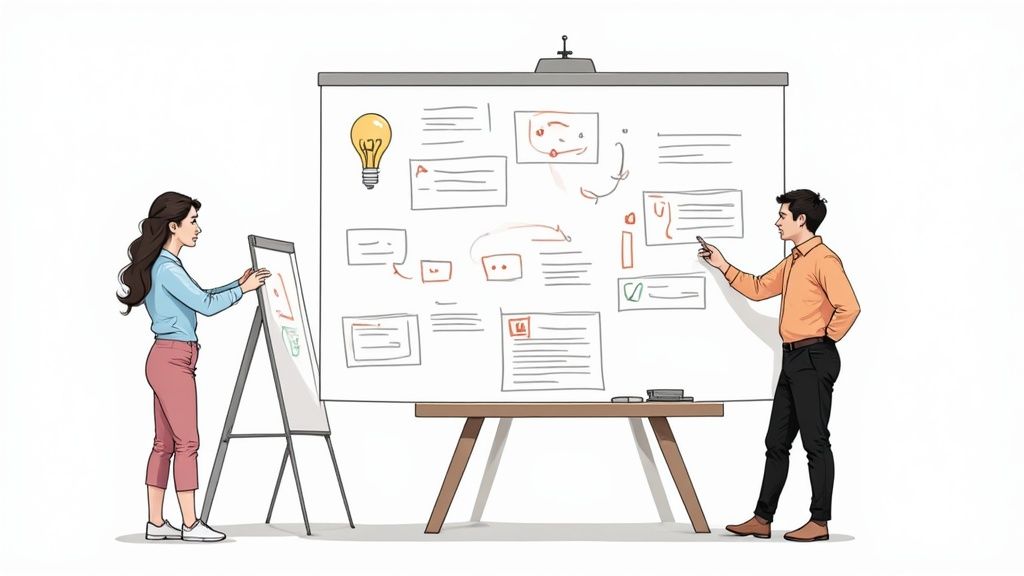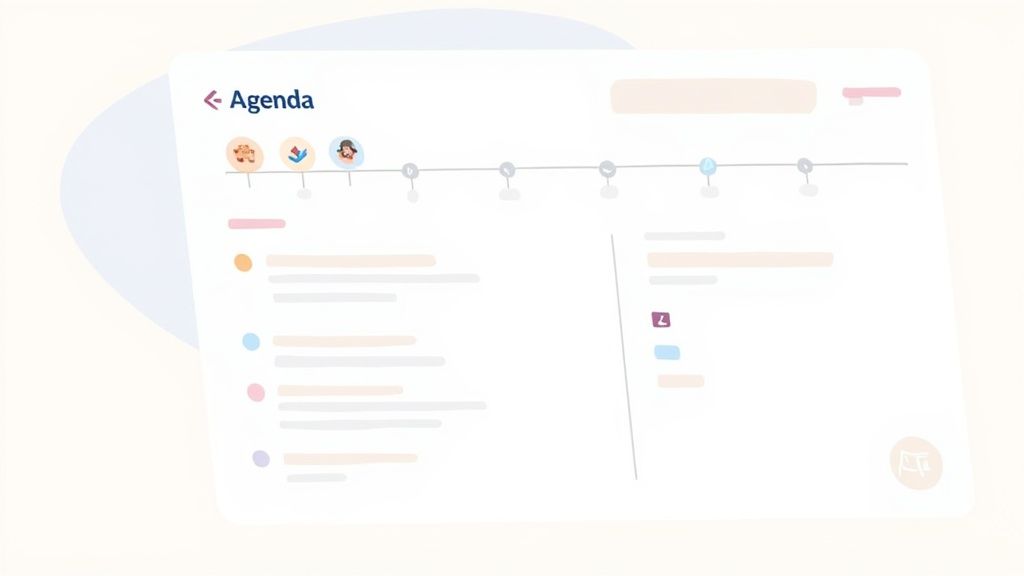Expert Tips for Planning Coaching Sessions


The Evolution of Coaching: Where We Stand Today

The coaching industry is constantly evolving, adapting to new trends and challenges. This dynamic landscape requires coaches to be flexible and consistently refine their methods for planning coaching sessions. Client expectations, for example, are changing, with a greater emphasis on personalized and results-oriented experiences. This necessitates a more strategic approach to structuring client interactions.
Adaptability is crucial for success in the coaching world. The ability to customize sessions to individual needs, incorporating current research and best practices, distinguishes thriving coaches from those struggling to remain relevant. Furthermore, the growing demand for niche coaching areas, such as executive coaching and life coaching, necessitates a deeper understanding of planning tailored coaching sessions within these specialties. Effective planning ensures both coach and client work together toward well-defined goals, optimizing the potential for positive outcomes.
Despite these shifts, the overall need for coaching services remains strong. Current data indicates approximately three million coaches across the UK, a figure that has held steady for the last six years. This underscores the consistent demand for coaching support in various areas, including physical activity and sports coaching for both children and adults. This consistent demand showcases the resilience of the coaching community. For a deeper dive into UK coaching statistics, see: Discover more insights about coaching in the UK
Embracing Change and Innovation
Modern coaches must embrace change and innovation to remain effective. This involves integrating new technologies, using data-driven insights, and keeping abreast of the latest research in human behavior and motivation. Digital tools, for instance, can streamline scheduling, enhance communication, and provide clients with convenient access to resources.
However, successful coaches understand the importance of maintaining a human-centric approach. They strike a balance between utilizing technology and fostering empathy and genuine connection. Planning coaching sessions now requires a delicate balance of art and science. It involves creating a structured framework while remaining adaptable to emerging client needs and insights.
This approach enables coaches to cultivate an environment for meaningful exploration and growth, empowering clients to reach their objectives and realize their full potential. Ultimately, the evolution of coaching emphasizes the continuous process of learning and adapting. This ensures coaching sessions remain impactful and relevant in an ever-changing world.
Core Elements That Make Coaching Sessions Transform Lives

What distinguishes a truly impactful coaching session from one that fades quickly from memory? The key lies in the careful preparation that happens beforehand. This doesn't imply rigidly adhering to a script. Instead, it's about building a framework that allows for both structure and adaptability. Effective planning considers key elements to maximize client development and progress.
Building a Foundation of Trust and Safety
A crucial element is establishing psychological safety. This involves creating an environment where clients feel secure enough to be vulnerable, take calculated risks, and explore difficult subjects. This resembles how a skilled therapist establishes a safe space for patients. This security allows clients to delve into personal barriers and uncover real breakthroughs.
Clear communication about the coaching process and expected outcomes is also vital from the start. By setting clear expectations, coaches build trust and rapport with clients, fostering a collaborative atmosphere. This foundation allows clients to actively participate in planning, ensuring the coaching objectives align with their personal aspirations.
Structuring for Impact and Flow
Effective sessions have a clear structure to guide the conversation and maintain client focus. However, this structure should be flexible enough to adapt to the client’s individual needs and the session's natural progression. Think of it like navigating a ship: you need a planned route but must also adapt to changing conditions.
A well-planned session might start with a check-in to assess the client’s current state, followed by reviewing previous goals and progress made. This provides context and flows naturally into exploring new challenges or refining current strategies.
Utilizing Powerful Questioning Techniques
The ability to ask the right questions at the right time is a hallmark of effective coaching. Open-ended questions encouraging reflection and self-discovery can unlock powerful insights. Instead of asking, "Are you happy with your progress?", a coach might ask, "What feelings come up when you reflect on your progress?" This nuanced approach facilitates deeper exploration.
Skilled coaches also incorporate pauses and silence. These intentional breaks give clients time to process, connect with their intuition, and formulate thoughtful responses. These moments of reflection can often lead to the most profound breakthroughs.
To help coaches structure their sessions, the table below outlines core components and considerations for effective planning:
Core Components of Effective Coaching Sessions
This table outlines the essential elements every coach should include when planning their sessions, rating each component by importance and implementation difficulty.
| Component | Purpose | Implementation Tips | Common Pitfalls |
|---|---|---|---|
| Building Trust & Safety | Establishing a secure environment for open communication | Clearly define coaching process and expectations; Active listening and empathy | Lack of clarity; Rushing the relationship-building process |
| Structured Session Flow | Maintaining focus and momentum | Establish clear agenda; Flexible adaptation to client needs | Rigid adherence to plan; Lack of client input |
| Powerful Questioning | Unlocking insights and self-discovery | Open-ended questions; Intentional pauses and silence | Leading questions; Interrupting client reflection |
| Cultivating Momentum | Driving engagement and action | Varied activities and exercises; Building on client insights | Lack of variation; Disconnected activities |
This table emphasizes the importance of balancing structured planning with adaptability and client-focused communication. By understanding these core components, coaches can create more impactful sessions.
Cultivating Momentum and Maintaining Focus
Planning also involves strategically sequencing activities to build momentum. This could involve incorporating various exercises, visualizations, or role-playing scenarios to deepen understanding. Like a conductor leading an orchestra, the coach guides the client through activities that build towards a crescendo of insight and action.
By orchestrating the session flow and using powerful questioning, coaches empower clients to explore challenging areas while maintaining focus and direction. This ultimately creates more impactful and transformative coaching experiences that facilitate lasting change.
Planning Coaching Sessions With Data-Driven Precision

Top coaches are using data-driven insights to revolutionize how they plan their sessions. This method empowers coaches to create highly effective sessions and demonstrate clear progress to their clients. Instead of relying solely on intuition, they use information gathered before, during, and after sessions to make more informed decisions.
This data-driven approach allows for a more personalized and ultimately more successful coaching experience for clients.
Gathering Meaningful Insights
Effective data collection doesn't have to be overwhelming. Instead of burying clients in endless surveys, focus on collecting practical and actionable information. Pre-session questionnaires, for instance, can help pinpoint client priorities and expectations, allowing coaches to tailor the session accordingly.
Short check-ins at the start of each session provide valuable real-time feedback on the client's current mindset. This continuous feedback loop keeps the coaching relevant and responsive to the client’s immediate needs. Observations during the session itself also provide crucial data.
Is the client engaged? Are there signs of resistance to certain topics? These non-verbal cues offer insightful feedback. Finally, brief post-session reflections help reveal the client’s key takeaways and pinpoint areas needing further support.
Combining these insights creates a clearer picture of client progress and informs future session planning.
Identifying Key Metrics
It’s important to remember that not all data is equally valuable. Some metrics might appear impressive at first glance, but they might not actually reflect positive coaching outcomes. For example, simply counting the number of sessions attended doesn't necessarily indicate progress toward goals.
Instead, concentrate on outcome-based metrics. Look for demonstrable changes in client behavior or achievement of specific objectives. This is where data tracking plays a vital role. Leading coaches use simple but effective tracking methods to identify patterns across sessions.
This might include noting recurring themes in client challenges, evaluating the effectiveness of various coaching techniques, or measuring progress toward pre-defined goals. Statistical analysis plays a critical role in planning coaching sessions, especially for assessing the success of coaching methods. This analysis can reveal important patterns.
Personalizing the Approach
The insights derived from data collection allow coaches to truly personalize their approach. If a client consistently struggles with self-doubt, for example, the coach can integrate confidence-building exercises into subsequent sessions. If data indicates a particular coaching technique isn’t effective, the coach can adapt their strategy.
This adaptive approach maximizes coaching effectiveness and reinforces client confidence. By demonstrating a commitment to data-driven improvement, coaches enhance their credibility and show clients they’re invested in their success. This approach cultivates trust and strengthens the coaching relationship.
This feedback loop of planning, execution, data analysis, and refinement creates a cycle of continuous improvement, resulting in more impactful and successful coaching engagements.
Tailoring Your Session Plans Across Coaching Specialties

Planning coaching sessions requires careful consideration of your specific niche. While core coaching principles remain constant, tailoring your approach is essential for maximizing client outcomes. The needs of an executive coaching client, for instance, differ significantly from those seeking life or wellness coaching. Adapting your planning process across various specialties is key.
Adapting to Different Coaching Domains
Consider the distinct objectives within each coaching discipline. Executive coaching, for example, often focuses on leadership development, strategic thinking, and performance improvement within a corporate setting. This might involve analyzing key performance indicators, conducting 360-degree feedback reviews, and setting SMART goals related to professional advancement.
Conversely, life coaching centers on personal growth, goal setting, and enhancing overall well-being. This could involve exploring personal values, identifying limiting beliefs, and developing strategies for greater life satisfaction.
Wellness coaching addresses physical and mental health, often focusing on stress management, building healthy habits, and positive lifestyle changes. This area has seen a surge in demand. The Health & Wellness coaching market in the UK was projected to reach US$392.80 million by 2023, with a projected CAGR of 13.60% between 2023 and 2028. This growth reflects the rising interest in services like stress management and nutrition guidance. Explore this topic further
Finally, sports coaching emphasizes skill development, performance enhancement, and strategic game planning. This involves analyzing player statistics, designing training regimens, and crafting winning strategies. Each area demands a unique planning approach.
Customizing Session Structure and Pacing
Session structure and pace should also reflect the coaching specialty. Executive coaching sessions might be more structured and time-bound, reflecting the corporate environment. Life coaching sessions, conversely, might be more exploratory and flexible, allowing time for self-reflection.
Milestone planning also varies. In executive coaching, milestones might be tied to specific business objectives or performance metrics. In life coaching, milestones might focus on personal growth markers or achieving individual goals. This ensures sessions are productive and aligned with client needs.
Questioning Frameworks and Program Coherence
Questioning techniques should also be adjusted. In executive coaching, questions might focus on strategic decision-making or leadership challenges. In life coaching, questions may explore personal values, beliefs, and motivations.
Despite these adaptations, maintaining coherence across a coaching program is crucial. This involves establishing clear overarching goals and ensuring each session contributes to the client's overall development. By recognizing which planning elements should remain consistent and where customization is necessary, you can deliver impactful coaching experiences. Effective planning is the cornerstone of successful coaching across all specialties.
A Proven Framework for Planning Coaching Sessions That Deliver
Stop improvising your coaching sessions. A structured, adaptable framework will consistently yield positive results, guiding clients toward meaningful outcomes while maintaining a natural and spontaneous feel.
Clarifying Objectives and Setting the Stage
Effective planning starts with clarifying session objectives. What specific outcomes do you and your client want? These should align with the client's broader coaching goals. For example, if a client aims for improved work-life balance, a session objective could be identifying three time management strategies. This provides clear focus.
Pre-session questionnaires are invaluable tools. They offer insights into the client’s current mindset, challenges, and priorities, enabling you to tailor the session to their immediate needs.
Structuring the Session for Maximum Impact
A structured session promotes focus and productivity. This isn't about rigidly following a script, but having a flexible framework. It’s like building a house: you need a blueprint, but you can personalize the interior. A typical structure includes a check-in, progress review, discussion of new challenges, and next steps planning.
The most impactful activities depend on the client and their objectives. A confidence-building session might involve role-playing, while a stress management session could include mindfulness exercises.
Contingency Planning for Unexpected Turns
Effective coaching anticipates potential detours. What if the client raises an unexpected issue or resists an activity? Contingency plans allow you to adapt without losing sight of objectives.
Having alternative activities or knowing how to gently redirect the conversation keeps the session productive, even with unexpected challenges.
Time-Tested Templates for Different Session Types
Templates for different session types boost planning efficiency. A goal-setting session template might include sections for identifying values, brainstorming goals, and creating action plans. This repeatable structure is easily customized.
A progress review template could include sections for reviewing accomplishments, identifying obstacles, and adjusting strategies. These templates serve as valuable starting points.
Post-Session Review and Continuous Improvement
Planning doesn't end when the session concludes. Post-session review is vital for continuous improvement. Reflect on what worked, what could be improved, and what adjustments might benefit future sessions. This feedback loop refines your approach.
To further illustrate the planning process, consider the following framework:
A brief introduction to the table explaining its purpose: The table below provides a detailed breakdown of a coaching session planning framework, from initial preparation to post-session review, including estimated time allocations for each phase. This framework helps ensure a structured and efficient approach to coaching.
| Planning Phase | Key Activities | Time Investment | Expected Outcomes |
|---|---|---|---|
| Pre-Session Preparation | Clarifying objectives, designing questionnaires, preparing materials | 1-2 hours | Clear session focus, client insights |
| Session Opening (10-15 minutes) | Check-in, rapport building, agenda review | 10-15 minutes | Client comfort and focus |
| Content Delivery (30-45 minutes) | Facilitated discussion, activities, skill-building | 30-45 minutes | Client learning and application |
| Session Closing (10-15 minutes) | Action planning, next steps, feedback | 10-15 minutes | Client commitment and clarity |
| Post-Session Review | Reflection, documentation, follow-up planning | 30-60 minutes | Coach development and improved client outcomes |
A short conclusion after the table summarizing key insights: By utilizing this framework, coaches can effectively structure their sessions to maximize client engagement and progress. Consistent application of this framework and regular post-session review allows for ongoing refinement and improved coaching effectiveness.
By integrating this framework, you create coaching sessions that feel natural yet effectively guide clients toward meaningful outcomes. This leads to a more fulfilling and successful coaching experience for both coach and client.
From Good to Exceptional: Refining Your Coaching Process
The journey from good to exceptional coaching hinges on continually refining your process. This goes beyond basic client satisfaction surveys. It means digging deeper into the effectiveness of your coaching sessions and understanding which feedback truly fuels improvement, and which is simply surface-level praise. It’s a continuous cycle of evaluation, adaptation, and growth.
Actionable Feedback vs. Ego-Stroking
While positive feedback is encouraging, it doesn't always provide the actionable insights needed for real growth. Instead of asking generic questions like, "Were you satisfied with the session?", consider more specific queries. For example, ask, "What specific element of the session resonated most with you and why?" or "What could I have done differently to make this session even more impactful?" These focused questions pinpoint specific areas for improvement and provide much richer data.
The Power of Documentation and Pattern Recognition
Successful coaches often document their sessions, noting key takeaways, client breakthroughs, and areas where the client struggled. This isn't about creating lengthy transcripts. Instead, it’s about capturing essential details that allow for pattern recognition across multiple sessions. This helps identify recurring themes, successful strategies, and areas needing adjustment. For instance, tracking the effectiveness of different questioning techniques can reveal which ones consistently elicit insightful client responses.
Identifying and Addressing Blind Spots
Every coach has blind spots – areas where they may be unknowingly hindering client progress. Peer supervision or mentoring, where fellow coaches offer feedback and insights, is one way to uncover these. Self-reflection is also vital. Regularly asking yourself questions like, "What assumptions am I making about my client?" or "Am I truly listening, or am I just waiting to offer my own perspective?" can illuminate areas needing attention. Addressing these blind spots requires deliberate action, perhaps seeking additional training, engaging in self-study, or adopting new coaching methodologies.
Establishing Meaningful Success Metrics
Meaningful success metrics go beyond client satisfaction. They should align directly with the client's stated objectives. For example, if a client's goal is to improve their communication skills, success might be measured by how confidently and effectively they handle challenging conversations. The coaching industry continues to expand, with the number of coaching practitioners reaching 109,200 in 2023, a 54% increase since 2019. Find more detailed statistics here. This growth underscores the increasing importance of demonstrating the value of coaching through quantifiable outcomes. Tracking progress toward clearly defined goals creates a tangible record of success, showcasing the value you provide and building client confidence.